Key takeaways:
- Child safeguarding policies serve as promises for children’s protection, requiring regular review and adaptation to address evolving challenges.
- Engaging stakeholders, including parents and professionals, enhances understanding of child safeguarding, leading to collaborative and effective strategies.
- Facilitating open discussions and using storytelling fosters emotional connections and collective ownership in policy development.
- Listening, flexibility, and transparency are essential in policy discussions to uncover valuable insights and build trust among stakeholders.
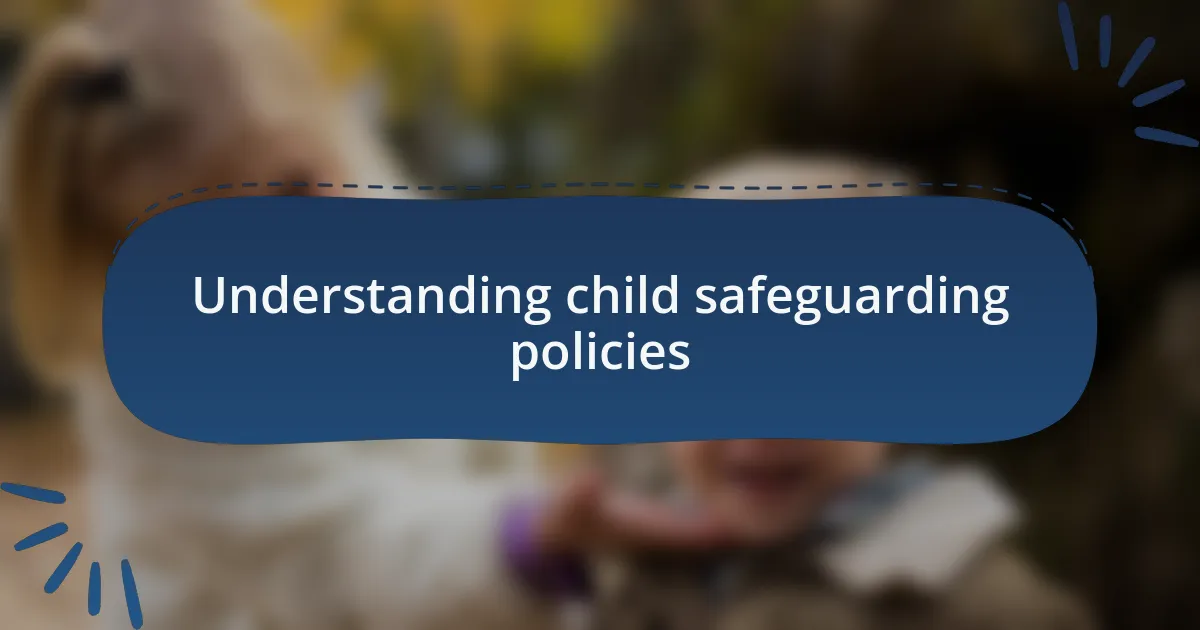
Understanding child safeguarding policies
Child safeguarding policies are essential frameworks designed to protect children from abuse and neglect, but understanding them goes beyond simply reading the documents. When I first delved into these policies, I was struck by how they not only outlined procedures but also reflected a shared commitment to the well-being of children. Isn’t it encouraging to think that these policies exist not just as rules, but as a promise that we make to the vulnerable?
During my journey, I remember engaging in a particularly intense discussion where we analyzed a case of policy failure. It was eye-opening to see how easily misunderstandings or poor communication can jeopardize a child’s safety. It made me wonder: how often do we revisit these policies to ensure they are relevant and effectively communicated? In my experience, regular review and adaptation of safeguarding policies are crucial for responding to the evolving nature of child protection challenges.
The language used in child safeguarding policies can sometimes seem daunting, filled with legal jargon that may alienate those most affected. I vividly recall an instance where breaking down the terms during a training session led to an “aha” moment for many attendees. It became clear that when we demystify these policies, we empower everyone—parents, educators, and community members—to actively participate in safeguarding efforts. Isn’t that what we all want, to feel equipped and informed to protect the children in our lives?
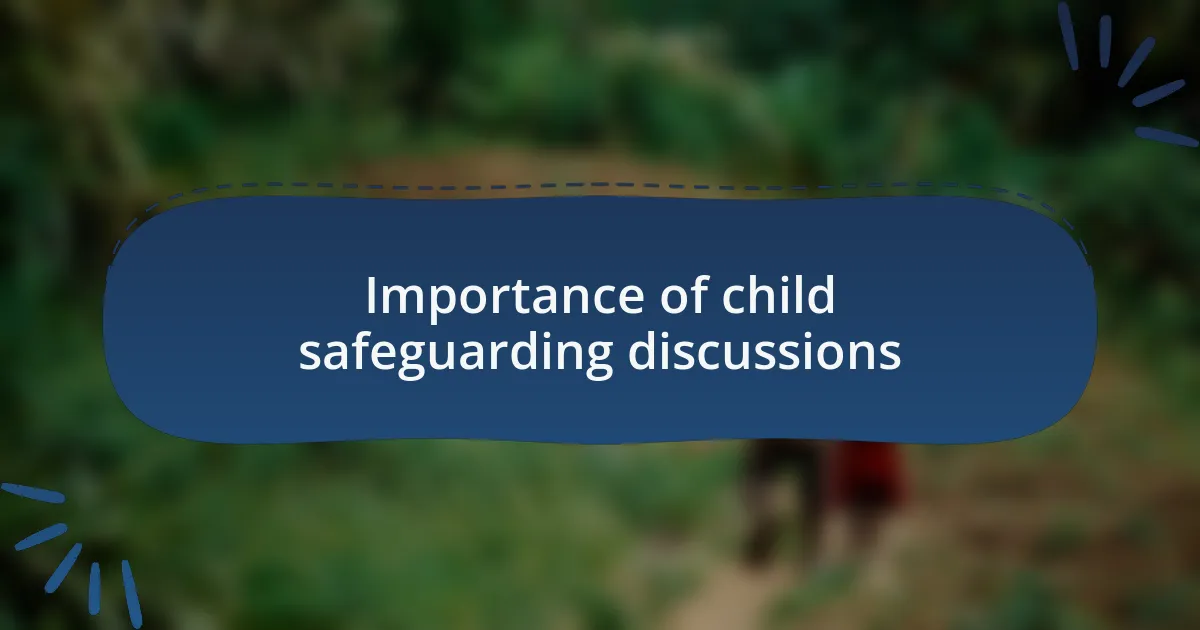
Importance of child safeguarding discussions
Discussions about child safeguarding are crucial because they foster awareness and communication among all stakeholders involved in a child’s life. I remember sitting in a community meeting where parents and educators shared their concerns about safety in schools. Hearing their anxiety and insights reinforced how vital it is for us to engage in open dialogues, as these conversations not only raise awareness but also strengthen our collective commitment to child welfare.
Child safeguarding discussions help to establish a common understanding of risk factors and solutions. In one of my previous roles, I facilitated a workshop where we analyzed local case studies and brainstormed preventive measures. The varied perspectives shared during those discussions made it clear that collaborative strategies are far more effective than isolated efforts. Don’t you think it’s empowering when everyone feels they have a voice in shaping policies that affect their children?
Moreover, these conversations can lead to innovative approaches that keep pace with societal changes and emerging threats. I often reflect on how our community adapted our child safeguarding practices in response to the rise of digital dangers and online interactions. As we continue to discuss and evolve our strategies, we can better anticipate challenges and create safer environments for children. Isn’t it comforting to know that together, we can build a supportive network focused on protecting vulnerable children?
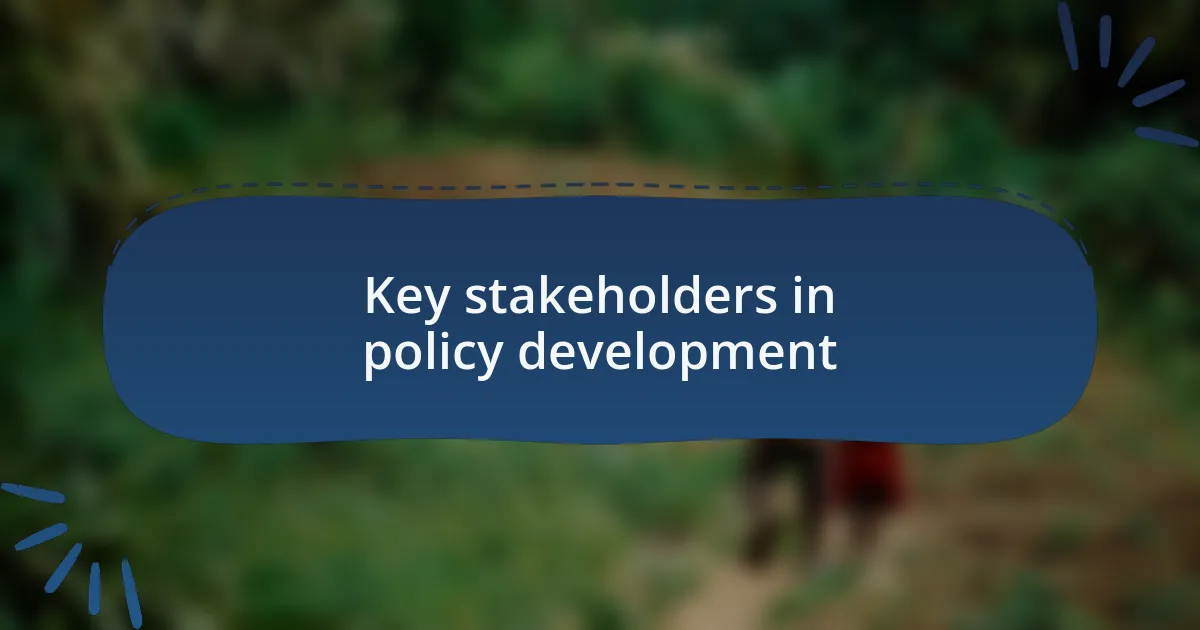
Key stakeholders in policy development
When it comes to policy development in child safeguarding, the involvement of multiple stakeholders is paramount. I recall being part of a task force that included social workers, local government officials, and even representatives from child advocacy organizations. Each voice brought unique insights that shaped our approach and illuminated various aspects of child welfare—who knew a simple meeting could yield such profound connections and solutions?
Parents, of course, are pivotal stakeholders as they directly understand the challenges faced by their children. In one instance, I remember a parent who bravely shared their story about navigating the complexities of school bullying. Their input not only resonated with others in the room but also highlighted the need for policies that are responsive to real experiences—doesn’t it make you think about how critical it is for parents to be engaged in these discussions?
Lastly, we can’t overlook the value of academic researchers and child psychologists, whose expertise informs evidence-based policy decisions. During a collaborative workshop, I was struck by the data presented by a researcher on the impact of trauma on child development. This kind of information is not just statistics; it’s a call to action. When we align research with the realities experienced by children and families, we create a robust framework for effective safeguarding policies. Shouldn’t we strive to ensure that research shapes our conversations, rather than merely observing from the sidelines?
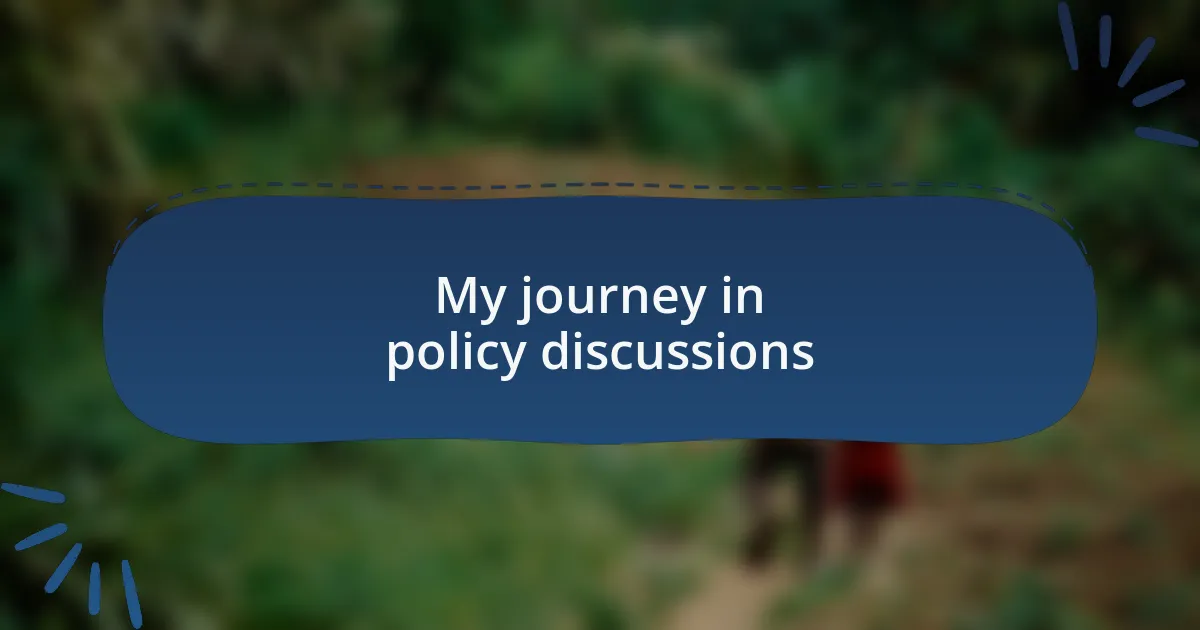
My journey in policy discussions
In my journey through policy discussions, I vividly remember the moment I first felt the weight of our words. During a heated debate on child protection measures, one of my colleagues shared a heart-wrenching story about a child who slipped through the cracks of our system. That moment crystallized for me the profound responsibility we bear as policymakers—are we truly doing enough for those we aim to protect?
As discussions progressed, I became acutely aware of the emotions driving our conversations. I’ll never forget a session where a social worker recounted the struggles of families caught in the midst of bureaucratic red tape. Listening to their frustration, I realized how vital it is to anchor policy discussions in genuine empathy—how often do we pause to truly listen to the voices that matter most?
Throughout these experiences, I found myself increasingly engaged in crafting policies that resonate with real lives. A few months back, I participated in a roundtable focused on improving mental health resources for children. The passion in the room was palpable, and it struck me how collective determination can spark change. How can we not be inspired by the potential to create safer, more supportive environments for every child?
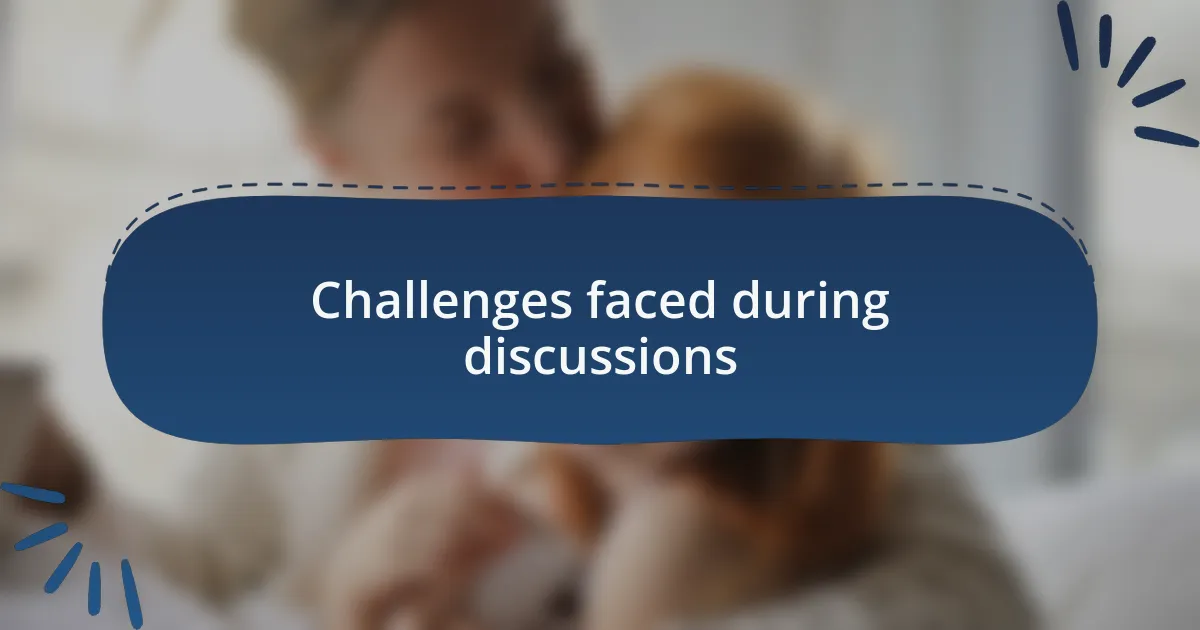
Challenges faced during discussions
During discussions, one significant challenge I’ve encountered is the clash of perspectives among stakeholders. I recall an instance where passionate advocates for children’s rights faced off against representatives from traditional institutions. The tension in the room was palpable. How do you reconcile the urgent need for change with the fear of disrupting established systems? It’s a delicate balance that often leaves us feeling stuck.
Another hurdle that frequently arises is the lack of data to support our arguments. I remember a meeting where we desperately needed statistics to illustrate the rise in abuse cases, but much of the available data was outdated or incomplete. This gap not only hindered our ability to persuade but also sowed doubt among participants about the effectiveness of proposed policies. Can we really push for reform without solid evidence? This question loomed large in that discussion.
Additionally, the emotional weight of the topics we address can sometimes overshadow rational discourse. In one particularly poignant session, discussions around childhood trauma elicited tears from even the most seasoned professionals. It made me wonder—how can we effectively navigate our emotions while still making pragmatic decisions? Balancing empathy and objectivity remains one of the most challenging aspects of these policy discussions.
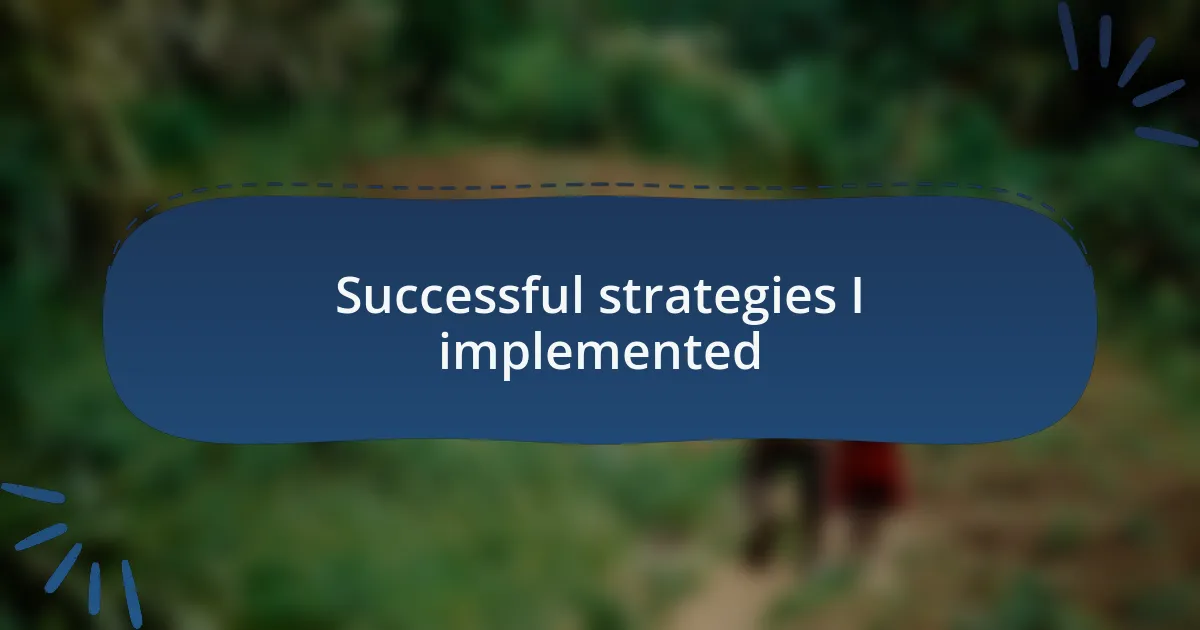
Successful strategies I implemented
One successful strategy I implemented was creating a collaborative platform for stakeholders to share their perspectives openly. I remember a workshop where we structured breakout sessions, allowing smaller groups to voice their concerns without the pressure of larger audiences. This approach not only fostered trust but also encouraged creative solutions to complex problems. Isn’t it amazing how a little space can lead to breakthroughs in understanding?
Another effective tactic was the use of compelling storytelling to connect with stakeholders on an emotional level. During a particularly tough meeting, I shared a powerful case study of a child who had been helped by our proposed policies. The room went silent, and I could see that people were moved. It struck me that facts and figures can numb us, but stories breathe life into our discussions. How often do we forget the faces behind the data?
Lastly, I focused on building consensus through shared goals. I initiated a discussion that led us to articulate our collective vision for child safeguarding. By asking everyone to express what success looked like to them, we found common ground and built a sense of ownership over the policy outcomes. It made me realize that when people feel invested in the process, they are much more likely to support the initiatives we aim to implement. Isn’t it fascinating how collaboration transforms potential resistance into shared enthusiasm?
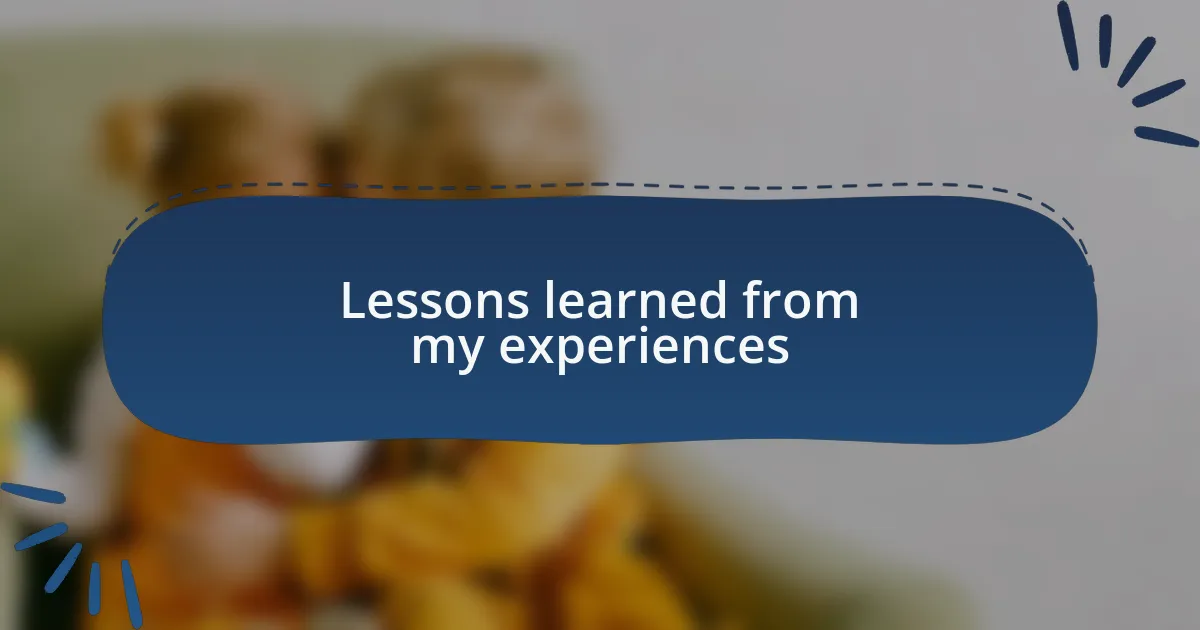
Lessons learned from my experiences
The most profound lesson I learned was the power of listening. I recall a meeting where emotions ran high, and rather than trying to assert my viewpoint, I asked open-ended questions to understand where others were coming from. This not only defused tension but also uncovered valuable insights that shaped our policies in ways I hadn’t anticipated. Have you ever found that sometimes simply being heard can make all the difference?
I’ve come to realize that flexibility is key in policy discussions. During one initiative, I prepared a strict agenda, but as the conversation unfolded, it became evident that certain topics needed more time and attention. By allowing the discussion to flow naturally, we unearthed issues that were more pressing than what I had initially planned. It taught me that rigidity can stifle crucial dialogues, and embracing adaptability can lead to richer outcomes.
Another significant lesson was the importance of fostering a culture of transparency. In one project, I shared both our successes and failures with stakeholders. Admitting our shortcomings was uncomfortable, yet it opened the floodgates for honest conversations. I often ponder how transparency can act as a bridge, fostering deeper trust and collaboration among all parties involved. Isn’t it surprising how vulnerability can strengthen relationships?